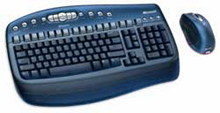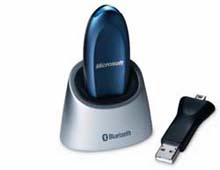

The new Wireless Optical Desktop for Bluetooth keyboard and mouse (above) and transceiver (below). Click images for high-res versions.
REDMOND, Wash., Nov. 12, 2002 — In October, Microsoft Hardware unveiled the peripheral industrys first commercially available desktop using Bluetooth wireless technology — Wireless Optical Desktop for Bluetooth. This new mouse, keyboard and USB transceiver combination has been available in the U.S. since early November and delivers unprecedented wireless freedom, mobility and security. Also available is the Wireless IntelliMouse Explorer for Bluetooth, sold separately with the USB transceiver.
Microsofts support for Bluetooth marks a major milestone for the technology and the industry, and analysts predict it will be a catalyst for increased development and use of wireless technologies — one of the fastest-growing segments of the personal devices industry.
Microsoft collaborated closely with the Bluetooth Special Interest Group (SIG), a consortium of companies that together develop and maintain the technology.
Mike Foley chairs the board of the Bluetooth SIG, and is a technical evangelist in the Microsoft Windows group. PressPass spoke with Foley, long a major proponent of Bluetooth technology both in the hallways of Microsoft and throughout the industry, to learn more about what users can expect from it, why Microsoft is supporting it, and how this technology — named for a Danish king — will enable new connections for users worldwide.
PressPass:
What exactly is Bluetooth?
Foley: Bluetooth is a short-range wireless technology that allows devices to exchange data without cables, providing greater flexibility in configuration. Most people today use infrared wireless devices, which have to be in line of sight of each other. The small degree of error is limiting to most users. Bluetooth devices, such as printers, cell phones, mice, keyboards and more, can communicate as long as they are within 30 feet (9.1 meters) of each other.
PressPass:
How does this differ from 802.11 or Wi-Fi?
Foley: Bluetooth is a low-power and low-cost USB and cable replacement technology that is best for personal devices. Wi-Fi is a high-speed wireless Ethernet replacement that is best for networking devices. We need two wireless standards for the same reasons we have both USB and Ethernet on todays PCs. Each is very much optimized for its particular application.
PressPass: Youre the chairman of the board of directors for the Bluetooth Special Interest Group. What is this organization?
Foley: The Bluetooth SIG is a trade association comprised of leaders in the telecommunications, computing and network industries. The Bluetooth SIG Promoters include 3Com, Agere Systems, Ericsson, IBM, Intel, Microsoft, Motorola, Nokia and Toshiba. There are also hundreds of associate and adopter member companies. The objective is to drive the development and implementation of Bluetooth wireless technology for widespread consumer awareness and use.
PressPass:
So you work at Microsoft and the Bluetooth SIG. You must be busy.
Foley: Actually, the jobs complement each other in many ways. At Microsoft, I evaluate wireless technologies to determine how best to integrate them into Microsoft products and work with partner companies to ensure that wireless hardware is available when Microsoft products are ready to support it. I also work with worldwide communications standards organizations to develop the standards required for interoperable consumer products.
My work, which encompasses the integration of and support in the Windows operating systems for PAN, LAN and WAN wireless technologies, is critical to delivering connected computing services to consumers and giving them access to their data anytime and anywhere. It is my overall goal to ensure that Windows is the best computer platform for wireless connectivity.
At the SIG, I am the chairman of the board, which means that I work with all the member companies to foster the growth and capabilities of Bluetooth, helping to aid in the adoption if this wireless technology throughout all disciplines and organizations. Therefore my work with the SIG and my current role at Microsoft fit perfectly together.
PressPass:
How is Microsoft working with the SIG now?
Foley: Microsoft has been a consistent supporter of Bluetooth, joining the SIG in December of 1999. Since then, Microsoft has taken an active role in the standards development. We are now offering support in the Windows XP and Windows CE.Net operating systems, as well as the new Wireless Optical Desktop for Bluetooth, a new keyboard, mouse and transceiver combination. These announcements represent a continuation of Microsofts long-term Bluetooth strategy.
Press Pass: The mouse and keyboard are Microsofts first Bluetooth gadgets, correct? Why is this a big deal for Microsoft?
Foley: Wireless Optical Desktop for Bluetooth enables new scenarios with the desktop PC, including greater PC setup flexibility. Bluetooth devices such as mice, keyboards, printers and mobile phones can be placed anywhere within 30 feet of one another and exchange information without worrying about cables or wires. Additionally, since the devices are built on the stable Windows XP platform, we can ensure their experience is going to be a positive one.
PressPass: Is Microsoft the only company offering Bluetooth products?
Foley: No. In fact there are a multitude of Bluetooth products from a wide variety of manufacturers available now — including cell phones, printers and headsetswith more to come in the short-term. The Microsoft Wireless Optical Desktop for Bluetooth, which includes mouse, keyboard and transceiver, is the first complete Bluetooth desktop available to consumers.
PressPass:
Microsoft and many other manufacturers already offer wireless keyboards and mice. Does the world really need a new wireless Bluetooth desktop?
Foley: The Wireless Optical Desktop for Bluetooth offers the same superior performance, comfort and style that users have enjoyed since Microsoft first began making mice 20 years ago. The key difference between this desktop and others now available from Microsoft is Bluetooth wireless technology.
First, Bluetooth offers greater wireless reliability, range and security than todays 27MHz wireless products. One of the main benefits of Bluetooth is as a replacement technology for USB cables; in short, getting the wires and cables off your desk.
Second, a single transceiver, such as the one offered in the Microsoft Bluetooth Desktop, can communicate with up to seven Bluetooth devices simultaneously, eliminating multiple device cables or independent 27MHz wireless receivers. This single transceiver can be used today and in the future with all Bluetooth devices users include in their desktop experience. If consumers are interested in a cable-free desktop, Bluetooth is the best choice as it is a better wireless technology, providing a connection to the PC for various devices all through a single transceiver.
PressPass: How does Microsoft support Bluetooth in Windows XP?
Foley: Currently, Windows is supporting three Bluetooth profiles. If youre not familiar with profiles, they are rules outlined by the SIG for device behavior. Profiles are how you can tell what scenarios each device will enable, and which Bluetooth devices will be operable with others. Windows currently supports Hard Copy Cable Replacement, Dial-Up Networking and Human Input Devices. This enables wireless printing to a Bluetooth printer, access to the Internet anywhere using a Bluetooth cell phone as a modem and using Bluetooth mice and keyboards for additional functionality and range. We will continue to add profiles to this list as we hear from consumers what scenarios they would like made possible.
PressPass: Are consumers ready for Bluetooth?
Foley: Yes. With the popularity of multiple personal devices, Bluetooth will enable consumers to better connect these devices anytime, anyplace. With the various Bluetooth devices available now, consumers can now print wirelessly, access the Internet from anywhere and clear their desk of cables with wireless mice and keyboards. We think that consumers are ready to make their first commitment to Bluetooth and experience the increased range, reliability and security that Bluetooth offers.
PressPass: How common will Bluetooth products be at retail this holiday season?
Foley: They are available now at retail, and projections are for greater availability over the next few months. The consumer market for Bluetooth products, as a whole, is growing. Gartner Dataquest, Inc. estimated last year that 186 million Bluetooth chipsets would be made in 2002, compared to 36 million in 2001. IDC recently reported that revenue from Bluetooth products, such as chips and memory used in devices, should grow from US$76.6 million in 2001 to $2.6 billion in 2006.
PressPass: Where do you see Bluetooth going? Will there be other products released to consumers that use the technology?
Foley: With support for Bluetooth in the Windows XP platform, the opportunity to use Bluetooth technology in personal devices is really limitless. We think youll begin to see Bluetooth technology replace more cables in products such as cameras, speakers and stereo headsets. This will allow consumers to connect more devices to the PC, one of the most-used devices in the home. Bluetooth will also be used in the automobile for hands-free computing in the car. The possibilities really are endless — it is a great time to upgrade devices to Bluetooth and experience the technology for yourself.




